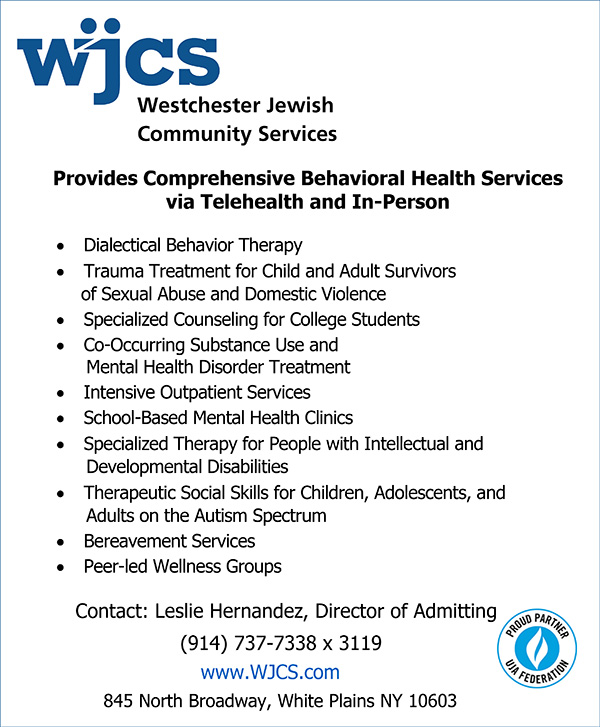In the fall of 2019, as part of our effort to increase client accessibility to treatment, Westchester Jewish Community Services (WJCS) was preparing to launch a telehealth program. The plan had been to start a small pilot in the spring of 2020, with a few staff providing telehealth sessions, as well as feedback and guidance for a larger scale launch to follow. The onset of the global pandemic not only hastened our plans, it drastically changed the scale of our initiative. Indeed, today approximately 65% of our services are being rendered via video-based telehealth, and WJCS, the largest provider of licensed outpatient community-based mental health services, has delivered over 80,000 video-based telehealth services since the start of the COVID-19 public health crisis. Consistent with our original plan, WJCS assessed our clients’ telehealth experiences during the fall of 2020, using both English and Spanish language survey methodology. The survey provided many important insights about our clients and the process of virtual data collection at a large community mental health agency. While some of the information garnered has become common knowledge, other findings came as a surprise, and several findings, although confirming what we anticipated, have been sobering.

The following information reflects data gleaned from a small sample of WJCS clients (n = 128). Survey results provided preliminary evidence that video-based telehealth has been well-received by our clients, with the majority of clients surveyed finding telehealth easy, convenient, private, and effective. Additionally, 97% of clients expressed a desire to continue with some proportion of video-based telehealth services, with 67% wanting exclusively remote services, at least until the conclusion of the pandemic. Further, of clients who received services before switching to telehealth, 30% confirmed that they had experienced significant barriers to accessing in-person treatment. These difficulties were primarily related to transportation, disability, and childcare. These results supported feedback from numerous clients who have expressed that telehealth, including video-based sessions, has been invaluable to them, helping them to get through the most challenging and isolating period of their lives. Further, these results highlighted how clients with access needs may receive services more equitably.
In addition to supporting clients’ positive impressions of telehealth, the survey results also reinforced the devastating impact of the current pandemic for our client population. The most striking results of our survey are a startling confirmation of the disproportionate adverse impacts of COVID on our clients. Due to COVID, 45% of our respondents experienced a change in household income, 25% experienced a change in employment, 25% suffered the loss of someone close to them, 15% live with someone who has had COVID, and 6% had COVID themselves. A third of clients experienced more than one of these impacts. These figures become even more sobering in light of the timing of the survey. When the survey was administered, approximately 7 million people in the U.S. (approximately 2% of the total U.S. population) had contracted COVID; the cumulative total, as of February 2021, was over 28 million people. Comparing our figures to that of the general population, our estimates suggest that our clients were 3x more likely to have had COVID themselves, compared to the general population. If those estimates hold, it may be that as many as 24% of our clients have now had COVID at this point in the pandemic. The overall toll of COVID on our clients is truly incomprehensible.
Although the results of this survey provide promising support for the benefits of telehealth, we recognize the limitations of our survey. Chief among them is that those least comfortable with technology or without reliable access to the internet may have opted out of text message and email reminders to take the survey. As a result, we obtained a 30% response rate and sampled only a small proportion of our clients. Additionally, we have heard from a small handful of clients, most who have very complex concerns and challenging life circumstances, that telehealth has not worked for them. It is essential to understand more about their experiences and dissatisfaction with telehealth.
This project highlights the value of surveying our clients and has prompted us to think about how to better prepare to collect data from them going forward. Cognizant that we may wish to survey clients more frequently, we plan to modify questions around preferences for contact reminders during intake so that we do not exclude the option to text or email clients when necessary since both represent vital forms of communication. When asking clients about their preferences to be contacted by phone, email, and text, we also plan to ask clients to use that information to survey them about their treatment experiences.
Finally, this project has highlighted the invaluable role of technology in meeting the treatment and support needs of our clients. Although transitioning to remote services (in particular as rapidly and on as large a scale as we did) had its challenges, we know that telehealth has provided a lifeline for many of our clients. Our data on the impact of COVID has confirmed fears that our clients have been disproportionately impacted by the pandemic. It also reaffirms the importance of us being well-positioned to offer a variety of ways they can access services. The challenges posed by these unprecedented times impel us to continue to learn more about our clients and further develop our capabilities so that we may better meet their needs.
Kelly Daly, MS, is a Psychology Fellow, Shari Reiter, MA, is a Psychology Fellow, Elana Spira, PhD, is Director of Research, and William Mullane, PhD, is Director for Innovation, Integration, and Community Partnership at WJCS. Learn more about WJCS at www.wjcs.com.





